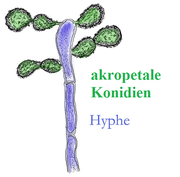- Conidium
-
Konidien (Syn. Konidiosporen, Akrosporen, Conidien) nennt man eine bestimmte Form von Sporen der Pilze, aber auch von Prokaryoten der Gattung Streptomyces. Bei den Pilzen zählen sie zu den Mitosporen, werden folglich ungeschlechtlich (mitotisch) außerhalb des Sporangiums durch Umbildung von Hyphen oder an Konidienträgern gebildet. Sie sind die für die höheren Pilze (Asco- und Basidiomyceten) charakteristischen Verbreitungsorgane der vegetativen Vermehrung. Bei der Gattung Streptomyces, welche zu den grampositiven Bakterien gehören, werden sie durch einfache Bildung von Querwänden im vielkernigen Sporophor generiert.
Ein- oder mehrzellige, sowie einfache oder komplizierte Formen sind möglich. Ebenso können Konidien in der Oberfläche glatt oder strukturiert, klein oder groß, farblos oder intensiv gefärbt sein.
Konidien werden von vielen Hautpilzen (Dermatophyten) gebildet. In der medizinischen Mykologie unterscheidet man die einzelligen Mikrokonidien und die mehrzelligen Makrokonidien.
Konidien treten beispielsweise im Sommer beim Apfelschorf auf und spielen als Auslöser vieler Pflanzenkrankheiten eine zentrale Rolle.
Auch einige Edelschimmel, die in der Käserei zum Einsatz kommen, gehören zu den konidienbildenden Schimmelpilzen, z. B. Penicillium camemberti und Penicillium candidum.
Literatur
- Hans Otto Schwantes: Biologie der Pilze. 1. Auflage. Ulmer, Stuttgart 1996, ISBN 3-8252-1871-6.
- Michael T. Madigan et al.: Brock Mikrobiologie. 9. Auflage. Spektrum, Berlin 2001.
Siehe auch
Wikimedia Foundation.

